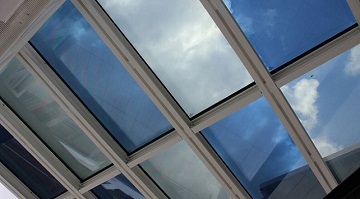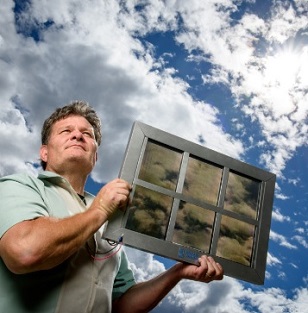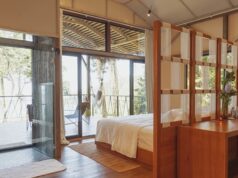
NATIONAL REPORT—Critical to the energy efficiency of any building is the quality of the window itself—its ability to insulate from infrared heat, potentially harmful UV rays, visible light, and cold air. Joseph Harary, President and CEO, Director, General Counsel, Corporate Secretary for Research Frontiers, says 18 to 20 percent of a building’s energy footprint is from windows. Fortunately for hotel owners, advancements in window design have made them highly effective insulators. Just as window design has improved significantly, so too have technologies that make the inner part of the window and the outside of the window contributors to energy efficiency and even energy generation.
Nine years ago, Mercedes-Benz began using Research Frontier’s SPD-SmartGlass in its vehicles. The electronically tintable glass was a perfect fit for the auto company’s upscale buyers. While using the glass, which goes dark in its “off” mode, Mercedes-Benz discovered that it reduced the inside temperature of its vehicles by 18 degrees when the cars were sitting in the hot sun. This increased driver comfort, reduced strain on the air conditioner and improved gas mileage. “On electrical vehicles you could increase driving range by 5.5 percent,” Harary says. Mercedes-Benz eventually added the tintable glass to all its S-Class sedans.
As Mercedes-Benz ramped up its adoption of SPD-SmartGlass, Research Frontiers developed it for other applications—commercial buildings such as hotels being one of them. Today, numerous hotels are beginning to use SPD-SmartGlass.
Activated by Low Voltage Charge
SPD-SmartGlass includes a film laminated inside the glass. With a low voltage charge the tint of the window can be adjusted to any shade including “clear.” The charge aligns tiny particles in the thin film. Tint shade can be adjusted with the touch of an iPad or iPhone, from a wall switch, dimmer, motion detector, light or temperature sensor, Zuli or other smartplug and can be easily integrated into any building control system.
Harary says SPD-SmartGlass can eliminate the need for shades or blinds and optimize day lighting potential. Stopping the buildup of heat caused by visible light has always been the “Holy Grail,” Harary says, but SPD-SmartGlass can block 99 percent of that light. It can do that while also effectively blocking infrared and UV rays no matter whether the glass is in its clear or tinted state.
Using a product such as SPD-SmartGlass can reduce heating requirements and protect interior furnishings and artwork from fading. It also helps reduce sound transfer. It is ideal not only for guestrooms and conference rooms but also for atriums and other hard to reach glasswork. There are no moving parts with SPD-SmartGlass. “There is no maintenance,” Harary says, adding that a building owner can right-size mechanical rooms and equipment by using SPD-SmartGlass.
Harary says SPD-SmartGlass, which qualifies a project for LEED points, is affordable and becoming more affordable. Research Frontiers currently licenses the technology to various companies including SmartGlass International. Those interested in learning more about SPD-SmartGlass can also go to www.smartglass.com and complete the contact form.
Electricity-Generating Windows

SolarWindow Technologies, Inc. creates transparent electricity-generating liquid coatings. The liquid coatings are primarily made of hydrogen and carbon—two of the most abundant materials found in nature. When applied to glass or plastics, these coatings convert passive windows into electricity-generating windows, which produce power under natural, artificial, low, shaded, and even reflected light conditions. Conventional solar does not work in shaded areas or perform under artificial light.
SolarWindow is targeting the estimated 5.6 million U.S. commercial buildings, which consume almost $150 billion in electricity annually. The company’s transparent electricity-generating windows could reduce energy costs by up to 50 percent and achieve a one-year financial payback for building owners, the industry’s fastest financial return, according to independently-validated company power and financial modeling.
Unlike the many acres of expensive downtown real estate required for solar array fields, SolarWindow systems can be installed on the readily-available vast window glass surfaces on tall towers and skyscrapers. SolarWindow can be applied to all four sides of tall towers.
According to SolarWindow Technologies, Inc., SolarWindow can outperform today’s solar by as much as 50-fold when installed on a 50-story building, according to independently validated power production calculations.
SolarWindow modules are created by applying ultra-thin layers of liquid coatings on to glass and flexible plastics. These liquid coatings produce ultra-small solar cells and form groups called “arrays.” The final product is generically referred to as an “organic photovoltaic solar array” (OPV).
Glenn Hasek can be reached at editor@greenlodgingnews.com.







